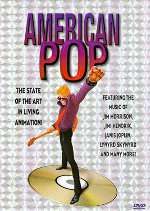Dr. Toon makes his case for 7 animated U.S. films he believes are worthy of National Film Registry preservation.
As we pulled those five-pound copies of “The Fairest One of All” from our groaning Christmas stockings, we held in our hands a chronicle of the most influential film in the annals of animation. In October of 2004 I wrote a column for this magazine detailing why the entire history of animation would have been different if Snow White and the Seven Dwarfs had not been a success. Snow White made artistic, economic, and production changes to the medium that still define it to this day, but it does not stand alone as a major influence on the development of animated features.
The National Film Registry represents selections by the United States National Film Preservation Board that merit preservation in the Library of Congress. Since 1989 (The first year the Board considered inclusions), 32 animated features and shorts have considered historically, culturally, or artistically important. Although many of the films included are considered “great”, that is not the most salient reason for inclusion. A film’s uniqueness may count for far more than box office take or unanimous, positive critical review.
Snow White, of course, is there, as are predictable entries such as Fantasia, Pinocchio, and Toy Story. However, some influential films never made it to the registry. Part of the reason is that only American films are eligible for inclusion. Another reason is that it is very difficult to reach consensus on what makes a film unique. The following list is for the consideration of my readers; it details some overlooked American films that, for reasons I will attempt to elaborate, may (someday) qualify for the registry. In reality, there may even be more; what I am suggesting are some of the better-known. Since short films are so numerous, I’ll stick with features. So, in no particular order:
OVERLOOKED IN AMERICA:

Fritz the Cat (1972, Ralph Bakshi, Dir.)
I have written before about how this film represented the dark side and decline of the youth counterculture. Bakshi so succinctly documented the death of 1960’s idealism and the souring of society under the curses of militarism, racism, and urban decay that the fact that Fritz was the first “X-rated” cartoon is actually secondary in consideration. The liberal use of drugs and violence is virtually taken for granted in this animated dystopia. Like some demented, cinematic John Updike, Bakshi averred that a sane way to face the decline of society was to seek solace in sex, sex, and more sex. Fritz the Cat, despite its glaring flaws, is a dark American original not easily ignored.
Hey There, It’s Yogi Bear (1964, William Hanna and Joseph Barbera, Dirs.)
No, I am not joking. This is an important picture for several reasons. To begin with, it was the first animated feature to be spawned by a television program. Had it not been commercially viable, the door might have remained closed for other TV-based cartoons to make the leap from the small to the big screen. It also allowed the HB studio to expand and change production venues. (A second feature, A Man Called Flintstone, would be in theaters two years later). These were major steps in making HB the premier TV animation studio in America at a time when the theatrical short was in its death throes. If nothing else, Yogi, Boo-Boo, Cindy and Ranger Smith proved that audiences who parked in front of the tube would go to theaters to see their adventures.

Who Framed Roger Rabbit (1988, Robert Zemeckis, Dir.)
It is rare that a single film revives an entire genre, but that’s more or less what happened in 1988 when cartoon zaniness and film noir got together in 1940s Hollywood. Having Richard Williams and his extensive animation vocabulary in the animation director’s seat surely helped as well. This film almost singlehandedly brought animation back to the forefront of entertainment after too many moribund years. Producer Steven Spielberg made a wholehearted commitment to small-screen shows following this film, and there is no doubt that Roger Rabbit influenced network and cable programming as well as fueled the revival of animated features at every major studio in the United States.

The Little Mermaid (1989, Ron Clements and John Musker, Dirs.)
Disney’s modern revival may have had roots as far back as The Great Mouse Detective, but the studio’s films reached an apogee with this retelling of the Hans Christian Andersen fairy tale. Disney’s first-string animators, headed by Glen Keane, Andreas Deja, Mark Henn and Reuben Aquino combined with composers Howard Ashman and Alan Menken to produce a Broadway-styled film that profoundly influenced the Disney output for years thereafter. Other studios soon followed suit, making The Little Mermaid the template for American animation entertainment in the 1990s. Although Beauty and the Beast (1991) was nominated for Best Picture at the Oscar Awards and did make the National Film Registry list, there is little doubt that The Little Mermaid paved the way.

American Pop (1981, Ralph Bakshi, Dir.)
Does the registry have something against this guy? America Pop is arguably Bakshi’s most accomplished film, a dark and bumpy journey through four generations of immigrant entertainers. Some deal with the mob, some with murderous Nazis, some with drugs…and some with fame. Every popular musical style from 1900-1980 is represented in a snapshot of American culture rarely rivaled in animation. Some purists decry the extensive use of rotoscoping, but this is one film uniquely suited to the method. Although the ending is somewhat unlikely, it is impossible to watch this film and not be affected by the conflicted history of the family Belinski. Add Louise Zingarelli’s expert character designs and Barry Jackson’s evocative background art, and you have a film that was sadly overlooked for the Registry.
The Nightmare Before Christmas (1993, Henry Selick, Dir.)
It was a mere matter of time until computer-generated animation conquered the silver screen, but just before its ascendancy Tim Burton and Henry Selick combined to make an iconic film whose methods harkened back to the earliest days of animation. The Nightmare Before Christmas is a stop-motion animated wonder, a warped fairy tale for the 1990s that has earned its place in film culture. Although Burton originally conceived the film as a possible TV special, it soon became clear that his weird but joyful vision was more suited to the big screen. Disney originally rejected the concept, wisely reconsidered, and the strangest holiday special in film history came to fruition. Gothic and ghoulish, bizarre and beautiful, the tale of Jack Skellington’s discovery of his true place in (after?)life is more than worthy of inclusion in the Registry.
The Iron Giant (1999, Brad Bird, Dir.)
1999 saw the release of two science-fiction movies, one highly hyped and anticipated, one virtually unpublicized. In this corner, George Lucas’ Star Wars Episode 1- The Phantom Menace. In the other corner, the little-known feature called The Iron Giant. Looking back from 2013, there’s no doubt that the underdog was likely the better film. Warner Bros. had concerns about the recent failure of their previous animated offering, The Quest for Camelot, but gave Brad Bird the go-ahead to turn Ted Hughes’ novel, The Iron Man, into a feature. Great decision. What Warner got was a very adult film set in 1957 complete with cold-war paranoia, the dark side of American militarism, and a uniquely American take on a popular theme in anime – can machines actually possess a soul? This unhurried, introspective film, bereft of the tendency to entertain through constant gags, showstopper musical numbers and frantic action, answers the question in a mature and touching way. Not only can a machine have a soul; when needed, it can have the soul of…Superman.
There you have it, seven films that deserve inclusion in the National Registry. Some are notable for economic influence, some for artistic reasons, and others for cogently capturing the culture that produced them. No cartoon feature is easy to produce, market, and find success in a country where animation has long been considered a children’s medium; except for Pixar (and less often Disney of late), expectations for a given animated feature are muted at best. Add to that the fact that many of them are not of superior quality or are tacked-on sequels, and it’s not hard to see why only six animated features have made the registry.
Is it too much to expect another six (OK, maybe Yogi Bear issomewhat of a reach if you discount its far-reaching effects on the industry) or seven animated features to be considered for future inclusion? Not really; taken on their own terms without comparison to other animated features or live-action films, there is a good case for each of them. It will be remembered that fame and profit are not the sole mechanisms by which films are considered, even though a couple of my candidates do meet that criteria. All it takes is a re-examination by the Board.
BTW: Anyone for Gulliver’s Travels? Always did have a soft spot for that film…
--
Martin "Dr. Toon" Goodman is a longtime student and fan of animation. He lives in Anderson, Indiana.








